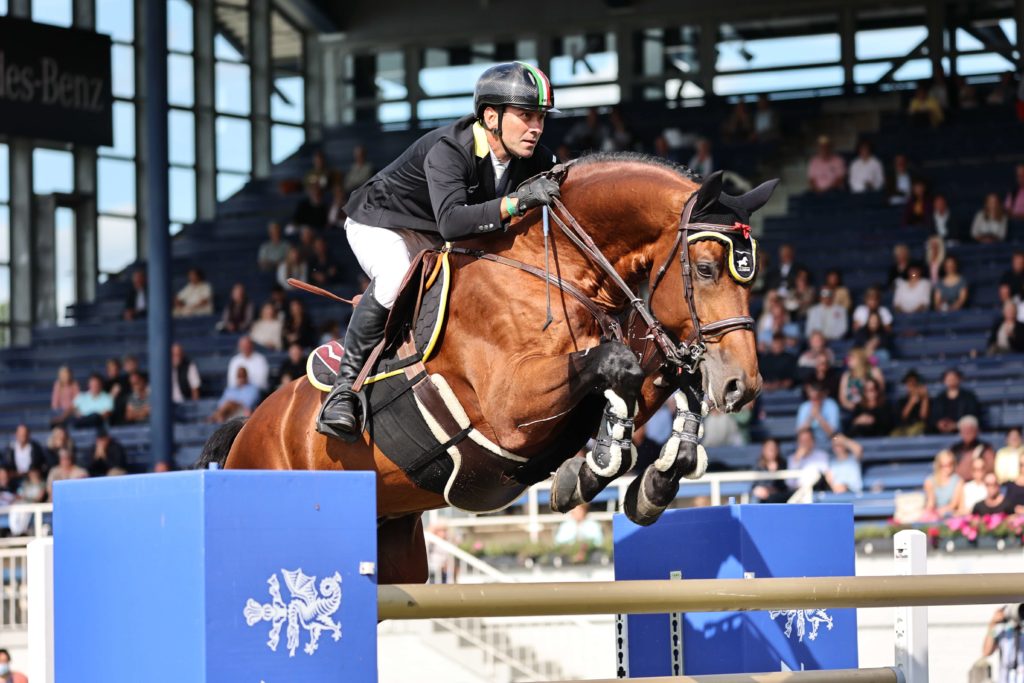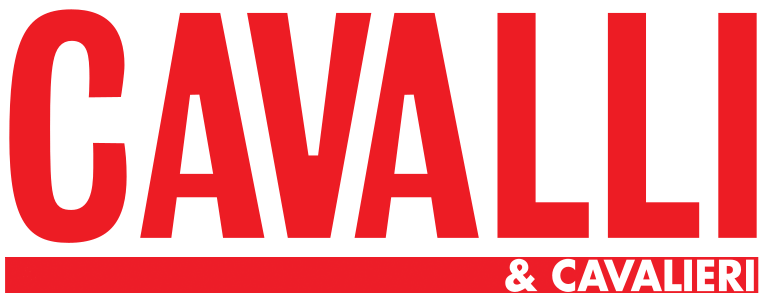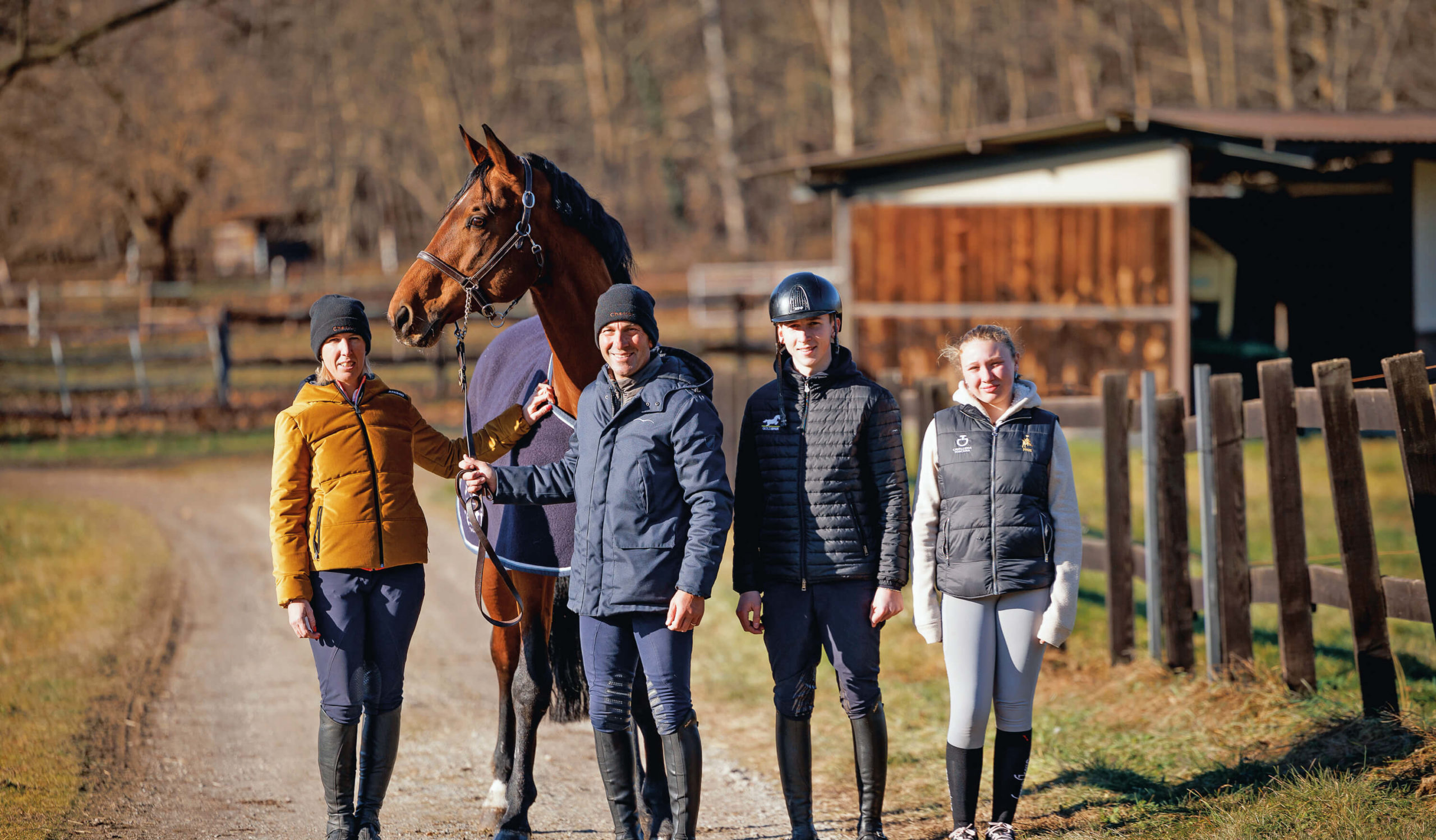AT THE PISANI’S
AT THE PISANI’S
Face to face with Riccardo Pisani: competence, experience, professionalism in the development of young horses and breeding, always aiming to the highest standards Riccardo Pisani was born in 1981, and he started riding at the age of six; had a good Pony and Junior career.
At 18 he won the Italian Junior Championships on Dionisos. With the same horse he then had a successful international Young Rider career. In 2008 he married Silvia Bazzani, and together they decided to start their own stables in northern Italy, investing in young horses to be trained for the sport at the highest levels. One of the first youngsters was Chico Z, who helped Riccardo to reach the highest international levels. In 2018 Chaclot, the performing stallion who changed his life, joined his team, leading him to become one of the top athletes of Team Italy.
Riccardo Pisani is today an established athlete who owes his success to the phenomenal Chaclot and to his skills in training and sporting growth of young horses. Silvia and Riccardo compete internationally exclusively with horses bred at their centre, Lozar Stables. In their team are also their two children; Andrea, already competing at an international level in the Children and Junior classes, and their youngest Iris who made her international debut a few months ago.
The interview
Your career has had a rapid growth from the early stages, reaching the highest levels with Chaclot.
Tell us about him.
There are two reasons we believe a lot in him: the first is his sporting qualities, his attitude, his scope, his strength, his mentality, his athletic capability; the second one is his pedigree. According to Italian and foreign professionals and breeders’ opinion, Chaclot is the horse that most resembles his father, Chacco Blue. This outstanding similarity between the two allows us to focus on him for breeding purposes
From the first moment, one of the things that impressed me the most about Chaclot was his rideability. I bought him from Schockemöhle, who kept him in Northern Germany, where he was ridden by a young rider who brought him up slowly. He was a big horse, with an athletic physique and long legs… and he was a very well-behaved stallion. I first tried him during the winter, and I could only jump him in an indoor arena. I immediately realised he had a lot of scope, a lot of potential and excellent quality.
At the end of the trial, we all thought that he could really be the horse of a lifetime, the one that could have made my career, the one that could have made the difference.
When I bought him, he had just turned eight. The first year together was about getting to know each other and establishing the foundations. He is a very big horse and at the beginning he was a little uncoordinated and gangly. It was only when I met Jos Lansink, in the autumn of the same year, that we made a big step up. Jos helped me understand him and get to know him; we worked on the details and his needs and from there Chaclot bloomed. In 2018 we started seeing the first results. Looking back at those competitions, I must say that in the World Cup rounds like Verona and those in the big arenas, he was really beautiful, and he always stood out. His versatility was extraordinary. He jumped in large arenas, on sand and in the indoor circuits with the same class, great athletic jump and the harmony that have always characterized him.

Today Chaclot is the progenitor of your breeding lines.
What is his offspring like?
Chaclot was approved for sporting merits in 2019. He started producing the first foals in 2020 then Covid forced us to pause the activity.
At home we have a four-year-old by Chaclot born from one of our very quality mares. We are looking forward to seeing his debut in the new season. I have seen some other very interesting four-year-olds both in Italy and abroad and I am very curious to see how they will perform.
My dream is to take a son of Chaclot to the highest levels. It would be nice to experience and remember. His progeny is still very young, so it will take years to see any results; perhaps it will be our son Andrea who will ride a son of Chaclot. We will see. Meanwhile I must say that I am very happy with what life has given me, with our family, our work and, obviously, our horses.
You mainly concentrate on training young horses. What are the foundations of this work?
Daily work is the key. You need to learn to recognize the correct daily routine for each horse, constantly trying to improve them by keeping them healthy and following the correct progression.
Instead of trying to achieve everything right away it is important to work hard to find the right pieces of the puzzle and to ensure that the horses continue their growth in their own individual timeframe. This is exactly what I’ve been doing for years.
We must try to reach the maximum that each horse can achieve but always waiting until they are ready for the next step with respect, allowing their physique to develop and each horse’s unique time of development. Some horses will end up being 130 horses, some of them 160 horses.
What matters is to increase step by step the growth of the horse, respecting his every moment, his physique and the circumstances that arise. Rushing and wanting to get everything right away is a waste of time, it is only counterproductive.
I train a lot of young riders, and I try to teach this mentality to them. Progression and goals. This leads to important results.
You are a rider of great experience and wisdom. What is your advice for young riders?
I feel they should first understand what horses they have, what they want to do and what they want to achieve.
Having said that, I try to make them understand how important it is to work progressively with consistency, get help and never think that a good result means that they have succeeded. With horses there is always something to learn, every day.
Even at my age I continue to get help. Plan and have clear ideas about what my horses need to do and respect their times.
First and foremost, we all respect our horses. We dedicate every day of our lives to them, and this has great value. We owe them respect, but we must pay attention to extremisms that do not help our sport and above all do not help the horses. Respecting our horses in every aspect, their learning times, their needs, is the priority of every rider and horseman. This is the deep meaning of our work.
The pride of the Lozar Stables is Chaclot, the show jumping stallion that took Riccardo to the highest peaks of show jumping and which today is the top progenitor of the stable’s breeding activity.




